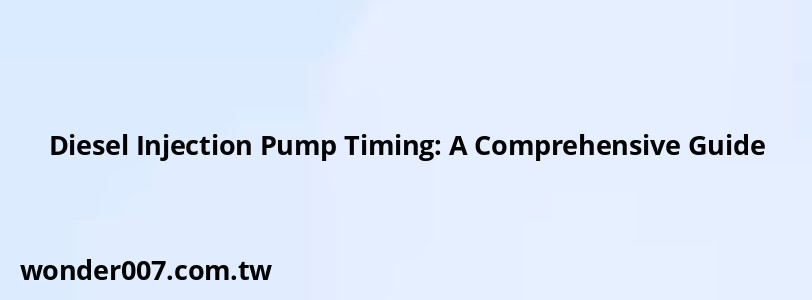Diesel Injection Pump Timing: A Comprehensive Guide

Setting the timing of a diesel injection pump is crucial for optimal engine performance. This process ensures that fuel is injected at the right moment during the combustion cycle, which can significantly affect power output, fuel efficiency, and emissions.
Understanding Diesel Injection Pump Timing
Diesel injection pump timing refers to the precise moment when fuel is injected into the combustion chamber relative to the position of the piston. Proper timing ensures efficient combustion, while incorrect timing can lead to poor engine performance, increased emissions, and potential damage.Why Timing is Important
- Engine Performance: Correct timing maximizes power output and efficiency.
- Fuel Economy: Properly timed injections can reduce fuel consumption.
- Emissions Control: Accurate timing helps meet emission standards by ensuring complete combustion.
Tools Needed for Setting Timing
To set the diesel injection pump timing accurately, you will need:
- Wrench set
- Timing light
- Dial indicator
- Basic hand tools (screwdrivers, pliers)
- Engine manual for specific timing marks
Steps to Set Diesel Injection Pump Timing
1. Preparation:
- Ensure the engine is off and cool.
- Disconnect the battery for safety.
2. Locate Timing Marks:
- Find the timing marks on the injection pump and crankshaft pulley. These marks indicate the correct alignment for setting timing.
3. Find Top Dead Center (TDC):
- Rotate the crankshaft until the first cylinder reaches TDC. This is when both intake and exhaust valves are closed.
4. Install Dial Indicator:
- Remove the timing-check plug from the injection pump.
- Insert a dial indicator into this hole to measure movement.
5. Adjust Timing:
- Rotate the crankshaft clockwise until the dial indicator shows a specific preload (usually around 2.5 mm).
- Rotate counterclockwise until it stops, then zero the dial.
- Return to TDC, and readjust if necessary by loosening the injection pump bolts and rotating it slightly to advance or retard timing as needed.
6. Final Checks:
- After adjustments, rotate the engine through several revolutions to ensure everything is functioning correctly.
- Reinstall any removed components and reconnect the battery.
7. Test Run:
- Start the engine and observe its operation. Look for smooth running without excessive smoke or noise.
Common Issues with Incorrect Timing
- Hard Starting: Difficulty in starting may indicate misaligned timing.
- Rough Idle: An uneven idle can result from poor fuel injection timing.
- Increased Smoke: Excessive black smoke during acceleration often signals that fuel is not burning completely due to incorrect timing.
FAQs About Diesel Injection Pump Timing
- How often should I check my diesel injection pump timing?
It’s advisable to check timing during routine maintenance or if you notice performance issues. - Can I adjust my injection pump timing myself?
Yes, with proper tools and knowledge of your engine's specifications, you can perform this adjustment. - What happens if I set the timing incorrectly?
Incorrect timing can lead to poor engine performance, increased emissions, and potential engine damage.
Setting your diesel injection pump timing correctly is essential for maintaining engine health and performance. Following these steps carefully will help ensure that your diesel engine runs efficiently and effectively.
Related Posts
-
Kia Optima Trunk Won't Open: Troubleshooting Guide
29-01-2025 • 208 views -
Speakers Only Playing On One Side Car: Troubleshooting Guide
27-01-2025 • 188 views -
How To Put RAV4 In Neutral: A Step-by-Step Guide
26-01-2025 • 150 views -
Isuzu Exhaust System Light Reset: A Complete Guide
26-01-2025 • 243 views -
2004 GMC Sierra Power Steering Pump Replacement
31-01-2025 • 96 views
Latest Posts
-
Rear Brake Caliper Piston Won't Compress
01-02-2025 • 361 views -
Are O2 Sensors Covered Under Warranty
01-02-2025 • 378 views -
Power Steering Fluid Leak On Passenger Side
01-02-2025 • 461 views -
2015 Chevy Traverse AC Recharge Port Location
01-02-2025 • 417 views -
How To Turn Off Paddle Shifters Mercedes
01-02-2025 • 387 views
Popular Posts
-
Toyota Hiace: Fuel Efficiency Insights for 2025
26-01-2025 • 645 views -
Power Steering and ABS Light On: Causes and Solutions
27-01-2025 • 649 views -
V12 Engine Costs: What You Need to Know
26-01-2025 • 688 views -
Hino Warning Lights: Understanding Dashboard Alerts
26-01-2025 • 794 views -
EPC Light: Understanding Causes and Solutions
26-01-2025 • 1065 views
